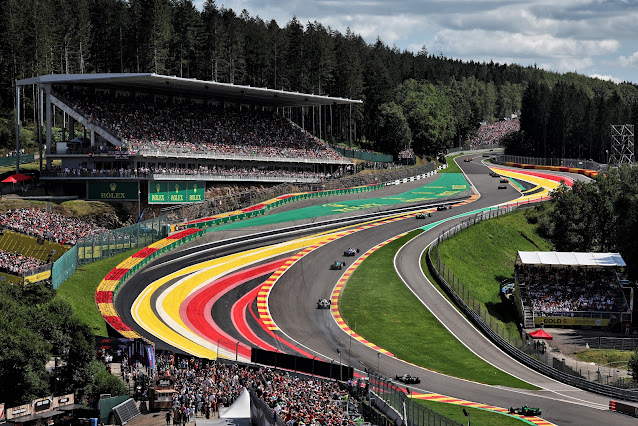Spa-Francorchamps: Beast of the Ardennes
As the Formula 1® season reached its mid-way point, with F1® driver news, and F1® news on and off the race track, it's now time to turn our focus to Spa-Francorchamps.
This world-famous race track is nestled in the rolling hills of the Ardennes forest, and the Belgian Grand Prix is synonymous with raw speed, dramatic elevation changes, and notoriously unpredictable weather. It’s a track that offers an actual test of bravery and skill, where legends are made and heroes are humbled.
This iconic circuit, first used for Grand Prix racing in 1925, has undergone significant evolution from its original 14 km public road layout. While it has undergone several redesigns for safety over the decades, most notably in 1979 when it was shortened, it remains the longest track on the current F1® calendar at 7.004 km.
Let's take a virtual tour of the Spa-Francorchamps circuit, corner by exhilarating corner, to understand the unique challenges and sheer thrill that Spa-Francorchamps delivers.
Sector 1: The Iconic Climb
- Turn 1 (La Source): The lap kicks off with a short blast from the start line before drivers hit the brakes hard for La Source, a tight, uphill hairpin.
- Turns 2, 3, 4 (Eau Rouge & Raidillon): is arguably the most famous corner sequence in all of motorsport. Compressed into a blind, steep, uphill right-left sweep called Raidillon. F1® cars often take this flat out, an astonishing testament to their downforce and the courage of their drivers. The G-forces are immense, and even a slight error can have dramatic consequences, making it a truly spectacular event.
Sector 2: Speed, Flow, and Technicality
- Turns 5, 6, 7 (Les Combes): After the incredible ascent of Raidillon, cars blast up the long Kemmel Straight, a significant DRS zone where slipstreaming overtakes are common.
- Turn 8 (Malmedy / Bruxelles / Rivage): This long, sweeping downhill right-hander is known by several names, reflecting the nearby towns.
- Turn 9 (Speaker's Corner): An unofficially named, yet deceptively quick, left-hand corner.
- Turns 10, 11 (Pouhon): This is one of Spa's most challenging high-speed sections. A double-apex left-hander, it's often taken flat or with just a slight lift, requiring immense commitment and perfect balance through continuous lateral load.
Sector 3: Forest Flow and The Final Decider
- Turns 12, 13 (Fagnes): A medium-speed right-left chicane that flows beautifully if executed correctly. Drivers must be precise on entry and smooth through the transition to maintain speed.
- Turns 14, 15 (Campus / Stavelot): These two fast right-handers lead onto the final high-speed sector. Prioritising a firm exit from Turn 15 is key to maximising speed onto Blanchimont.
- Turns 16, 17 (Blanchimont): A flat-out (in most cars) high-speed left-hand kink. It's taken at immense speed and demands complete confidence in the car's stability. It's a blur of raw power and commitment.
- Turns 18, 19 (Bus Stop Chicane): The final obstacle before the main straight. This tight right-left chicane is a heavy braking zone and a prime overtaking spot before the checkered flag. It was reprofiled in 2007 to accommodate a new pit lane entry, but it remains a challenging and decisive final sequence.
The Spa Challenge: Pure Racing Heaven
Spa-Francorchamps is a pure driver's circuit. Its mix of long, flat-out sections, technical complexes, and iconic elevation changes, combined with the often capricious Ardennes weather (it can be raining on one part of the track and dry on another!), makes for a unique and exhilarating experience.
It puts every aspect of an F1® car to the test, from engine power and aerodynamic efficiency to braking stability and tyre management.
It's a track that never fails to deliver thrills, spills, and heart-stopping moments. Prepare for another classic this weekend!
And as always, when the lights go out, and the drama unfolds, here at Senate Grand Prix, there is only one winner, and that's you, the race fans!









Comments
Post a Comment